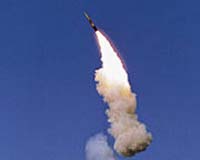 On Sept. 27, the Russian navy successfully carried out an operation that Putin especially appreciated, given his long commitment also to trying to revive the navy: The R-30 submarine-based "Bulava" missile R-30 (pictured) was successfully launched for the first time.
On Sept. 27, the Russian navy successfully carried out an operation that Putin especially appreciated, given his long commitment also to trying to revive the navy: The R-30 submarine-based "Bulava" missile R-30 (pictured) was successfully launched for the first time.
Fall is the season around the world when the leaves fall from the trees, but in Russia this year, it has also been the season when intercontinental ballistic missiles designed to overwhelm missile defense systems take their wings and soar into the heavens.
For Russian President Vladimir Putin's long efforts to renovate Russia's still formidable Strategic Rocket Forces are bearing fruit. Within the past two-and-a-half weeks, Russia has conducted no fewer than six successful strategic missile launches.
The tests have been an interesting mixture of old and new. On Sept. 27, the Russian navy successfully carried out an operation that Putin especially appreciated, given his long commitment also to trying to revive the navy: The R-30 submarine-based "Bulava" missile R-30 was successfully launched for the first time.
The other tests were less showy. As analyst Pavel Baev wrote for the Eurasia Daily Monitor of the Washington-based Jamestown Foundation Tuesday, "Five other tests, however, including the Sept. 30 launch from the
Georgii Pobedonosets from the Pacific Fleet and the Oct. 7 and 8 launches from
Borisoglebsk of the Northern Fleet, involved missiles of old types that have to be tested repeatedly, since technically they are past their expiration date."
American analysts tend to discount the value of such weapons and such tests, an attitude that in recent years has even infected Russian analysts writing in Moscow. But such confidence, or arrogance, may well be misplaced. Over the past century Russian military, space and missile and technology have repeatedly astonished and confounded the world by getting impressively reliable results from unassuming, simple or supposedly obsolescent technology.
One classic example was the old Mir space station, a supposed "death trap" on which not a single Russian cosmonaut or U.S. astronaut ever lost their lives or came close to it, a striking and sobering contrast with the immolation of seven astronauts on the Columbia space shuttle during reentry over Palestine, Texas in February 2003.
For the key point about all six major missile tests that the Russian armed forces conducted in late September and early October is that the weapons actually worked. The rocket engines fired and the missiles went where they were supposed to.
This was a striking contrast to what happened in two of the last three tests of America's anti-ballistic missile interceptor rockets. The high-tech, state-of-the-art, incredibly sensitive and sophisticated guidance systems never had a chance to strut their stuff because the rocket engines never ignited in the first place and the rockets stayed on the ground.
Some 16 of the interceptors are scheduled to be deployed by the end of this year, but critics charge that their component parts have not been adequately tested in advance for reliability.
By contrast, the component parts of the Russian ICBMs, including most of the old ones, seem to have been working just fine. Other devices being developed in the Russian strategic and space arsenals certainly appear more problematic. Baev noted that a new space "parachute" demonstrator that constituted the payload in the Oct. 7 missile launch was lost in the Okhotsk Sea.
"That was the fourth failed test of this device, and the launches of international space vehicles Kryosat and Kosmos-1 ... were also unsuccessful due to missile failures," he wrote.
However, the current series of tests suggests that the Russians have finally overcome the humiliating series of glitches that led to two successive failures to launch missiles from nuclear submarines
Novomoskovsk and
Kareliya in the February 2004 exercises.
Baev noted in his analysis that the Russian authorities insist their strategic forces remain "fully combat capable and undergo modernization in order to deter new kinds of threats." He also observed that President Putin "is always keen to praise new missiles that could penetrate any strategic defense 'being developed by certain of our partner countries.'"
Historically, Russian technology has always specialized in taking a beating and just going on running. To this day U.S. astronauts and Russian cosmonauts are launched to the International Space Station from the same launch pad in at Baikonur Cosmodrome in Kazakhstan that Yuri Gagarin, the first human being in space, was launched into earth orbit from in April 1961.
The launch pad was not designed to keep functioning for 44 years and its design was obsolete by Baikonur standard within a couple of years of Gagarin's flight. But as long as it kept working the Russians kept on using it.
That kind of design philosophy applies to Russian ICBMs as much as it did to the Mir space station or the Baikonur launch pad. The point about those five old missiles that were test-fired in the Arctic over the past few weeks, after all, is that, when they needed to, they worked just as well as the new one.





 Reply With Quote
Reply With Quote
Bookmarks